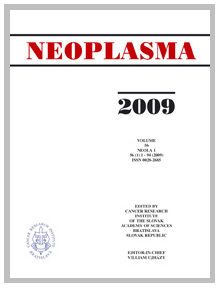Journal info
|
||
Select Journal
Journals
Bratislava Medical Journal Ekologia - Ecology Endocrine Regulations General Physiology and Biophysics Neoplasma 2025 Ahead of print 2024 2023 2022 2021 2020 2019 2018 2016 2017 2015 2014 2013 2012 2011 2010 2009 2008 2007 2006 2005 2004 2003 Acta Virologica Studia Psychologica Cardiology Letters Psychológia a patopsych. dieťaťa Kovove Materialy-Metallic Materials Slovenská hudba 2025Webshop Cart
Your Cart is currently empty.
Info: Your browser does not accept cookies. To put products into your cart and purchase them you need to enable cookies.
Neoplasma Vol.59, No.6, p.693-699, 2012 |
||
| Title: TRAV gene expression in PBMCs and TILs in patients with breast cancer analyzed by a DNA melting curve (FQ-PCR) technique for TCR alpha chain CDR3 spectratyping | ||
| Author: X. Y. HE, W. M. YANG, W. T. TANG, R. MA, Y. P. SUN, P. WANG, X. S. YAO | ||
| Abstract: Purpose. To explore the expression of the TRAV gene in peripheral blood mononuclear cells (PBMCs) and in tumor-infiltrating lymphocytes (TILs) in the patients with breast cancer using a DNA melting curve (FQ-PCR) technique for T cell receptor (TCR) alpha chain CDR3 spectratyping. Peripheral blood samples and tissue samples were obtained from thirty breast cancer patients. Total RNA was extracted from PBMCs and tumor tissues and then reverse transcribed into cDNA. FQ-PCR was used to amplify the human TCR alpha chain CDR3 region with the primers to the TRAV and TRAC genes. TCR alpha chain CDR3 spectratyping and partial CDR3 sequencing were used to determine use of TRAV gene product in T cell responses. TCR alpha CDR3 spectratyping showed preferential usage of certain TRAV genes in the PBMCs and TILs of all patients with breast cancer. The frequencies of TRAV1.1, TRAV9, and TRAV29 exceeded 30% in PBMCs and the frequencies of TRAV1.1 and TRAV22 exceeded 30% in TILs. More than three quarters of the patients (23/30) overexpressed the same gene in both PBMCs and TILs; for example, patient-1 highly expressed TRAV9 in the PBMCs and TILs. Patients with positive or negative tumor markers of estrogen receptor (ER), progesterone receptor (PR), pS2, C-erbB-2, nm23, P53, and Ki-67 showed no significant common TRAV gene expression, but some TRAV gene preferential usage frequencies exceeded 20%. For example, five of seven patients positive for ER had high levels of expression of TRAV1.1 and TRAV3. Finally, the amino acid sequence of TCR CDR3 region showed some common motifs in some of the patients. Conclusions. TRAV gene expression was complex and diverse in the patients with breast cancer. The TRAV gene usage may be closely related to the diversity of breast tumor antigens and the differential immune responses observed in individual patients. Research into the immunological mechanism of T cells may provide guidance for individual T cell-directed therapy for breast cancer. |
||
| Keywords: breast cancer, TRAV gene, TCR CDR3 spectratyping, FQ-PCR, DNA melting curve | ||
| Published online: 01-Aug-2012 | ||
| Year: 2012, Volume: 59, Issue: 6 | Page From: 693, Page To: 699 | |
| doi:10.4149/neo_2012_088 |
||
|
|
 download file download file |
|

